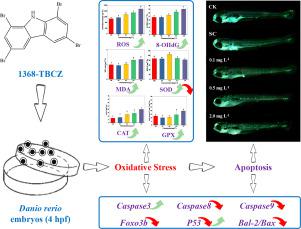Science of the Total Environment ( IF 8.2 ) Pub Date : 2020-07-10 , DOI: 10.1016/j.scitotenv.2020.140753
Jingwen Zhang 1 , Cheng Zhang 1 , Zhongkun Du 1 , Lusheng Zhu 1 , Jun Wang 1 , Jinhua Wang 1 , Bing Li 1

|
Since polyhalogenated carbazoles (PHCs) have been widely detected at high concentrations in multiple environmental media in recent years, the health risk of exposure to these compounds has drawn increasing attention. Most studies have mainly focused on their dioxin-like toxicity, which is induced through the AhR pathway, because PHCs have structures similar to those of polychlorinated dibenzofurans (PCDFs). In addition, most xenobiotic compounds induce oxidative stress in organisms, which is a more common mechanism of toxicity induction. However, there is limited information regarding the oxidative stress and damage induced by PHCs in vivo. The PHC 1,3,6,8-tetrabromocarbazole (1368-TBCZ) is detected at high concentration and frequency. In the present study, the toxic effects (acute toxicity, developmental toxicity, oxidative stress, and apoptosis) induced by 1368-TBCZ at three different concentrations were investigated using zebrafish embryos. It was concluded that the 96 h median lethal concentration (LC50) of 1368-TBCZ for zebrafish embryos was greater than 2.0 mg L−1. The results showed that 1368-TBCZ had little effect on the hatching rate of zebrafish embryos. However, 1368-TBCZ at 0.5 and 2.0 mg L−1 inhibited skeletal and cardiac development. It promoted ROS production, CAT enzyme activity, lipid peroxidation, DNA damage, and apoptosis, even at the lowest dose (0.1 mg L−1). In addition, 1368-TBCZ influenced oxidative stress-related gene expression, upregulating the expression of caspase 3 and p53 at 2.0 mg L−1 and inhibiting the expression of caspase 9, FoxO3b, and Bcl-2/Bax. The present study comprehensively evaluated 1368-TBCZ-induced toxicity in zebrafish, providing valuable data for better evaluation of the potential risks posed by this PHC.
中文翻译:

新兴的污染物1,3,6,8-四溴咔唑在斑马鱼的胚胎发育过程中诱导氧化损伤和细胞凋亡(Danio rerio)。
由于近年来已在多种环境介质中广泛检测到高浓度的多卤代咔唑(PHC),因此接触这些化合物的健康风险引起了越来越多的关注。大多数研究主要集中在通过AhR途径诱导的二恶英样毒性,因为PHC的结构类似于多氯二苯并呋喃(PCDF)。另外,大多数外源性化合物在生物体中诱导氧化应激,这是一种更常见的毒性诱导机制。但是,关于体内PHC引起的氧化应激和损伤的信息有限。在高浓度和高频率下检测到PHC 1,3,6,8-四溴咔唑(1368-TBCZ)。在本研究中,毒性作用(急性毒性,发育毒性,氧化应激,使用斑马鱼胚胎研究了1368-TBCZ在三种不同浓度下诱导的细胞凋亡和凋亡)。结论是96 h的致死浓度(LC斑马鱼胚胎的1368-TBCZ中有50)大于2.0 mg L -1。结果表明,1368-TBCZ对斑马鱼胚胎的孵化率影响很小。但是,0.5和2.0 mg L -1的1368-TBCZ抑制骨骼和心脏发育。即使在最低剂量(0.1 mg L -1)下,它也能促进ROS的产生,CAT酶活性,脂质过氧化,DNA损伤和细胞凋亡。此外,1368-TBCZ影响了氧化应激相关基因的表达,在2.0 mg L -1上调了caspase 3和p53的表达,并抑制了caspase 9,FoxO3b和Bcl-2 / Bax的表达。。本研究全面评估了1368-TBCZ诱导的斑马鱼毒性,为更好地评估此PHC带来的潜在风险提供了有价值的数据。

































 京公网安备 11010802027423号
京公网安备 11010802027423号